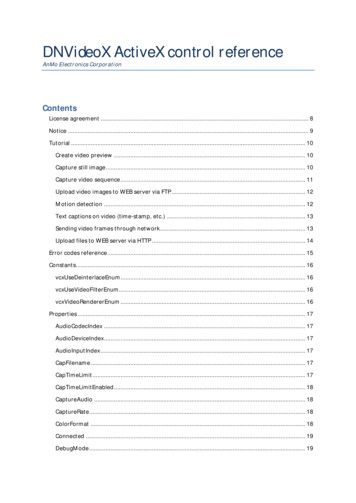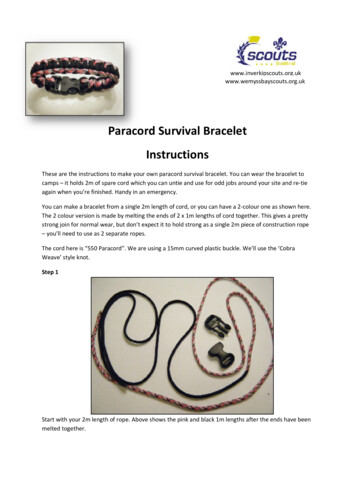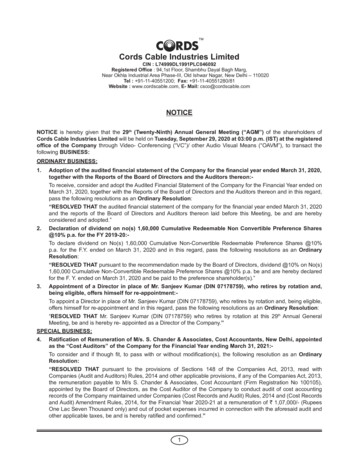
Transcription
TOWERINGEXTINCTIONS,BURSTINGMIND-BLOWING STATSMOSTFAMOUSDINOWEIRDESTDINOMeet the dinos crowned king in each category, checkout the runners-up that barely missed the top prize,and feast your eyes on fantastic facts and features,awesome prehistoric profiles, entertaininginfographics, amazing discoveries, fun and games,and so much more! In a dynamic yet easy-to-readformat, Dino Records is a visual feast of colorfulillustrations surrounded by a high-energy designand fascinating information that will captivate kidswith all the extremes.SMALLESTMODERN-DAYDINODEADLIESTDINO DOWNUNDERDINO RECORDSFROMTITANOSAURSTO TINY-BUT-TERRIBLE MEAT-EATERS,FROM FIRST EVER FINDS TO EARTHSHATTERINGNATIONAL GEOGRAPHIC KIDS’ DINO RECORDSISWITH THEMOSTAND STORIES OF THE DAYS WHENDINOSAURS ROAMED THE EARTH.DINO RECORDSTHE MOST AMAZINGPREHISTORICEVER TOCREATURES ONEARTH!HAVE ationalgeographic.com 14.99 U.S. / 19.99 CAN / 9.99 UKI S B N 978-1-4263-2794-0 / PRINTED IN CHINA514999 781426 327940Dino Records PBCvr REL REV2 HY.indd 1JEN AGRESTA ANDAVERY ELIZABETH HURTNGS14890-00 Cover PB.pgs 01.04.2017 14:141/4/17 2:07 PM
Dino Records Ch1 REL HY.indd 1NGS14890-00 P 1-1.pgs 12.22.2016 15:4312/22/163:39 PM
MUSSAURUSDino Records Ch1 REL HY.indd 2NGS14890-00 P 1-2.pgs 12.22.2016 15:4612/22/163:42 PM
AND THE WINNER IS .RUASONATITTHE(TIE-TAN-OH-SORE)Titanosaurs were mega-colossal sauropod dinosaurs—long-necked plant-eaters whose ranksincluded the largest dinos that ever lived. In 2012 arancher in a remote area of the Patagonia region ofArgentina found a bone belonging to what scientistsnow believe may be the largest titanosaur of all and thebiggest animal ever to have walked the Earth. More than220 bones from this still-to-be-officially-named species(which is being called simply “the Titanosaur”) have beenexcavated, allowing paleontologists to estimate the weightof this humongous herbivore at a whopping 70 tons(63.5 t)—about as much as 10 African elephants, the largest land animal alive today. The Titanosaur’s neck alonewas about as long as a school bus, and its heart—whichmay have weighed as much as three adult humans—couldpump almost 24 gallons (90 L) of blood in one beat!12Dino Records Ch1 REL REV2 HY.indd 12NGS14890-00 P 6-12.pgs 01.03.2017 15:521/3/17 3:51 PM
AMONG THE TITANOSAURFOSSILS DISCOVERED WAS AFEMUR (THIGH BONE) LONGERTHAN AN ADULT HUMAN.TYPE: SAUROPODDIET: HERBIVOROUSLIVED: 100 TO 95 MYARANGE: SOUTH AMERICAWEIGHT: 70 TONS (63.5 T)LENGTH: 122 FEET (37 M)HEIGHT: 65 FEET (20 M)BIGGEST 13Dino Records Ch1 REL REV2 HY.indd 13NGS14890-00 P 7-13.pgs 01.03.2017 15:521/3/17 3:51 PM
MORERUNNERS-UP .Meet some record-breakingdinos that were the biggestof their kind.BIGGESTARMORED DINOANKYLOSAURUS(AN-KYE-LOH-SORE-US)WARNING: Approach with caution. Thesquat, four-legged Ankylosaurus wasno fearsome predator, but it was covered in spikes and in defensive armormade from hundreds of bony plates—even on its eyelids! About 20 feet (6 m)long, the largest of the “tanklike” herbivores known as ankylosaurs roamedNorth American woodlands at the endof the Cretaceous period.16Dino Records Ch1 REL HY.indd 16NGS14890-00 P 8-16.pgs 12.22.2016 15:4712/22/163:43 PM
BIGGEST DINO WITHBIRDLIKE WINGSZHENYUANLONG(JEN-HWAHN-LONG)The 125-million-year-old nearly completeskeleton of this prehistoric raptor wasunearthed in northeast China’s Liaoningprovince. Could the largest dino withbirdlike wings and feathers ever foundactually fly? Scientists think not. It hadarms that were short compared withother dinos in its family, and—at about44 pounds (20 kg)—was pretty heavy.Scientists think the wings might havebeen for display, like a peacock’s.BIGGESTPLATED DINOSTEGOSAURUS (STEG-OHSORE-US)My, what beautiful plates you have!Up to 30 feet (9 m) long and weighingmore than 2 tons (1.8 t), late JurassicStegosaurus was the largest of theplate-backed, plant-eating dinosaursknown as stegosaurs. It sported tworows of staggered, diamond-shapedplates along its neck, back, and tail.Scientists over the years have debatedthe purpose of the pointy plates but nowsuspect that they were used for display,perhaps to attract potential mates.BIGGEST DOME-SKULLED The largest of the pachycephalosaurs (“domed dinosaurs”),late Cretaceous Pachycephalosaurus had a supersized skullcap—about 20 times thicker than other dino skulls. Someexperts think these plant-eating boneheads may have usedtheir distinct domes to head-butt each other, but others say thecreature’s neck was not strong enough to withstand the craniumcollisions without breaking. Now that’s a head-scratcher!Dino Records Ch1 REL REV2 HY.indd 17NGS14890-00 P 9-17.pgs 01.03.2017 13:141/3/1712:37 PM
SPOTLIGHTSESNEFEDODINos used their amazingdingtineantplaerethwhresuforowScientists don’t knrbivores were armedhesethetbu,insuscousroivorncairattributes to battle theused to defend themselves.vehauldcoytheyswaedckwiyettprwith someARMOR: GASTONIA(GAS-TONE-EE-AH)Prickly Gastonia was covered in heavy, defensive armor. To protect it from the strong jawsof meat-eaters it had four horns on its head,thick layers of bone shielding its brain, rowsof spikes sticking out from its back, and a tailwith triangular blades running along each side.SPIKES:KENTROSAURUS(KEN-TROH-SORE-US)Stand back! This cousin of Stegosaurus hadpaired spikes along its tail, which it couldswing at attackers with great speed. Onepaleontologist estimated that Kentrosauruscould have swung its treacherous tail fastenough to shatter bones!76Dino Records Ch3 REL HY.indd 76NGS14890-00 P 6-76.pgs 12.22.2016 16:4812/22/164:45 PM
CLUB TAIL:ANKYLOSAURUS(AN-KYE-LOH-SORE-US)Steer clear! Ankylosaurus possessed a heavy,knobby tail that it could have used to whackattackers. It may not have totally protected thetanklike late Cretaceous dino from a determinedT. rex, but a serious swing could have generatedenough force to do some real damage to its rival reptile.WHIP TAIL:DIPLODOCUS(DIH-PLOD-UH-KUS)Some scientists think this late Jurassicgiant’s tail—about half the length of its90-foot (27-m) body—could have beenused like a whip and swished at highspeeds, creating a loud noise that wouldsend potential predators running.HORNS: TRICERATOPS(TRI-SER-UH-TOPS)There’s no evidence Triceratops ever used its horns to combat late Cretaceoussnack-craving carnivores. But scientists do believe the famous three-hornedcreature used its frills and horns in battle with other members of its species.DEADLIEST 77Dino Records Ch3 REL REV2 HY.indd 77NGS14890-00 P 6-77.pgs 01.03.2017 13:141/3/1712:48 PM
BY THE NUMBERSHOWWASOne of the weirdest things aboutdinosaurs is how long ago theylived. So long that it’s reallyhard to imagine. Take a look atwhen these familiar animalsappeared on Earth—and howmuch time passed betweensome key appearances.LONG AGOTHAT?TYRANNOSAURUS REXMAMMOTHS65 MILLION5 MILLIONYEARS AGO(LATE CRETACEOUS)YEARS AGO200,000YEARS AGO112125 MILLIONIGUANODONYEARS AGO(EARLYCRETACEOUS)HOMO SAPIENSDino Records Ch4 REL HY.indd 112NGS14890-00 P 10-112.pgs 12.23.2016 06:2512/22/165:36 PM
EORAPTOR228 MILLIONYEARS AGO(LATE TRIASSIC)210 MILLIONMEGALOSAURUSYEARS AGO(LATE TRIASSIC)166 MILLIONSTEGOSAURUSYEARS AGO(MIDDLE JURASSIC)159 MILLIONYEARS AGO(LATE JURASSIC)COELOPHYSISWEIRDEST 113Dino Records Ch4 REL HY.indd 113NGS14890-00 P 10-113.pgs 12.23.2016 06:2812/22/165:32 PM
AND THE WINNER IS .The winner for weirdest dino is so zany,even its discovery was puzzling! In 1965in the Gobi desert, fossil hunters founda pair of eight-foot (2.4-m)-long armssporting three eight-inch (20-cm)-longclaws. To what mysterious creature were theyonce attached? Scientists could only imagine.Nearly five decades later, they had locatedenough other fossils of Deinocheirus mirificus(“unusual terrible hand”) to finally develop aclearer picture of the uncanny animal.Deinocheirus walked tall on two legs andwas as gigantic as T. rex and yet, somehow, looks like it would have been a lotless intimidating to creatures in thelate Cretaceous. Maybe it’s the peculiarproportions—the long, pointed head; theducklike, toothless snout; the huge, ganglyarms (the longest known of any animal ontwo legs!); the sail-like hump on its back; thebig belly—or maybe it’s the mash-up of all ofthe above. That’s one quirky creature!96Dino Records Ch4 REL HY.indd 96NGS14890-00 P 2-96.pgs 12.23.2016 06:2512/22/165:35 PM
DEINOCHEIRUS(DYE-NUH-KYE-RUS)TYPE: ORNITHOMIMOSAURDIET: OMNIVOROUSLIVED: 70 MYARANGE: MONGOLIAWEIGHT: 13,000 POUNDS (6,000 KG)LENGTH: 36 FEET (11 M)HEIGHT: 16 FEET (4.9 M)WEIRDEST 97Dino Records Ch4 REL HY.indd 97NGS14890-00 P 2-97.pgs 12.23.2016 06:2712/22/165:32 PM
THE RUNNERS-UP .Meet somedinos that defyimagination.THE MYSTERYDIGITIGUANODON(IG-WAN-OH-DON)Cool thumb, bro’.Scientists are not entirelysure why Iguanodonhad spiked thumbs, butsome hypotheses arethat this enormous earlyCretaceous plant-eaterused them for closerange defense againstpredators, in combat withother Iguanodon, or for(yawn) digging into fruitsand seeds. That’s onestrange spike!98Dino Records Ch4 REL HY.indd 98NGS14890-00 P 3-98.pgs 12.23.2016 06:2512/22/165:35 PM
THE COLOSSAL CLAWTHERIZINOSAURUS (THERE-IH-ZIN-OH-SORE-US)Therizinosaurus’s approximately three-foot (0.9-m)-long talons—thelongest claws known of any animal—look like they could have mademincemeat of potential prey. But Therizinosaurus was actually anherbivore that researchers believe used its claws to pull down treebranches for snacking. The massive, five-ton (4.5-t) dino likely stillused its monster claws to defend itself against predators in lateCretaceous Mongolia, where it lived 70 million years ago.THE DRACULA DINOPEGOMASTAX(PEG-OH-MAST-AX)A beak like a parrot, teeth like a vampire, and quills like a porcupine? Yup,it’s really weird. This tiny, two-legged,200-million-year-old herbivore wasless than two feet (0.6 m) long andweighed about as much as a kitty cat.Pegomastax’s fierce-looking fangsmight lead you to believe they didsome damage in the Jurassic, butthis pint-size plant-eater likelystuck to nuts and seeds.THE ORIGINAL BIG BIRDGIGANTORAPTOR (GEE-GANT-OH-RAP-TER)Feathered, toothless, and towering, Gigantoraptor isthe biggest oviraptorosaur ever found: 3,000 pounds(1,400 kg) and (at its shoulder) twice the height of aman. Despite its odd and outsized appearance, theomnivorous Gigantoraptor was probably not a fearsomepredator; the 26-foot (8-m)-long chickenlike creaturelikely ate plants—though it possibly also swallowedsome smaller animals whole.WEIRDEST 99Dino Records Ch4 REL HY.indd 99NGS14890-00 P 3-99.pgs 12.23.2016 06:2712/22/165:32 PM
from towering titanosaurs to tiny-but-terrible meat-eaters, from first ever finds to earth-shattering extinctions, national geographic kids' dino records is bursting with the most mind-blowing .








![BCA160 Macrame [2015] - NDSU](/img/19/bca160.jpg)

